Australopithecines - Study guides, Class notes & Summaries
Looking for the best study guides, study notes and summaries about Australopithecines? On this page you'll find 55 study documents about Australopithecines.
All 55 results
Sort by
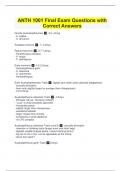
-
ANTH 1001 Final Exam Questions with Correct Answers
- Exam (elaborations) • 18 pages • 2024
-
Available in package deal
-
- $10.99
- + learn more
Gracile Australopithecines - 3.5-<2mya - A. sediba - A. africanus Possible hominins - 7- 4.4mya Robust hominins - 2.7-1.2mya - Paranthropus robustus - P. boisei - P. aethiopicus Early hominins - 4.2-2.5mya - Australopithecus garhi - A. afarensis - A. anamensis - Kenyanthropus Early Australopithecines Traits - bipeds (but retain some arboreal adaptations) - sexually dimorphic - brain only slightly larger on average than chimpanzee's - 4.2-2.5mya Australopithecus afarensis Traits - 4-3mya...
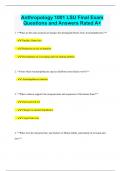
-
Anthropology 1001 LSU Final Exam Questions and Answers Rated A+
- Exam (elaborations) • 21 pages • 2024
-
- $9.99
- + learn more
Anthropology 1001 LSU Final Exam Questions and Answers Rated A+ 1. **What are the main anatomical changes that distinguish Homo from Australopithecines?** - Smaller, flatter face - Reduction in size of dentition - Development of scavenging and tool-making abilities 2. **From which Australopithecine species did Homo most likely evolve?** - Australopithecus robustus 3. **What evidence supports the reorganization and expansion of the human brain?** - Increased tool use - ...
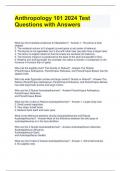
-
Anthropology 101 2024 Test Questions with Answers
- Exam (elaborations) • 6 pages • 2024
-
Available in package deal
-
- $13.49
- + learn more
Anthropology 101 2024 Test Questions with Answers What are the 6 skeletal evidences for Bipedalism? - Answer-1. The pelvis is bowl shaped. 2. The vertebral column is S-shaped (curved spine to set center of balance). 3. The big toe is not opposable, but in line with other toes (we also have a larger heel). 4. The femur is angled inward so that the knees are centered (for balance). 5. The foramen magnum is positioned at the base of the skull and parallel to floor. 6. Relative arm and l...

-
Evolution notes (matric ieb) - Life sciences
- Summary • 27 pages • 2022
-
Available in package deal
-
- $8.84
- 5x sold
- + learn more
Complete notes on evolution and hominid studies for ieb matric. Comprehensively typed in bulleted form. Includes summary tables of homids; Australopithecines and homo species. These notes helped me achieve a distinction and be placed in the top 1% for Life Sciences.
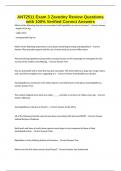
-
ANT2511 Exam 3 Zavodny Review Questions with 100% Verified Correct Answers
- Exam (elaborations) • 10 pages • 2024
-
- $10.49
- + learn more
Which of the following features are associated with bipedalism as seen in humans? - Correct Answer - length of the leg - valgus knee - nonopposable big toe Which of the following statements is true about nonhoning chewing and bipedalism? - Correct Answer They preceded speech and the use of stone tools by several million years. The provisioning hypothesis proposed by Lovejoy focuses on the advantage of monogamy for the survival of the mother and offspring. - Correct Answer True You are...
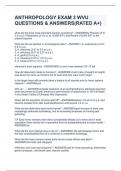
-
ANTHROPOLOGY EXAM 3 WVU QUESTIONS & ANSWERS(RATED A+)
- Exam (elaborations) • 7 pages • 2024
-
Available in package deal
-
- $11.99
- + learn more
what are the three most important hominin evolutions? - ANSWERthe Pliocene (5 to 2 m.y.a.), Pleistocene (2 m.y.a. to 10,000 B.P.) and Recent (10,000 B.P. to the present) epochs What are the six species in chronological order? - ANSWER1. A. anamensis (4.2 to 3.9 m.y.a.). 2. A. afarensis (3.8? to 3.0 m.y.a.). 3. A. africanus (3.0? to 2.0? m.y.a.). 4. A. garhi (2.5 m.y.a.) 5. A. robustus (2.0? to 1.0? m.y.a.). 6. A. boisei (2.6? to 1.0 m.y.a.). afarensis's brain capacity - ANSWER450 cc ...
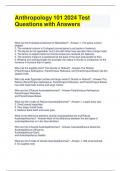
-
Anthropology 101 2024 Test Questions with Answers
- Exam (elaborations) • 6 pages • 2024
-
Available in package deal
-
- $13.49
- + learn more
Anthropology 101 2024 Test Questions with Answers What are the 6 skeletal evidences for Bipedalism? - Answer-1. The pelvis is bowl shaped. 2. The vertebral column is S-shaped (curved spine to set center of balance). 3. The big toe is not opposable, but in line with other toes (we also have a larger heel). 4. The femur is angled inward so that the knees are centered (for balance). 5. The foramen magnum is positioned at the base of the skull and parallel to floor. 6. Relative arm and leg len...
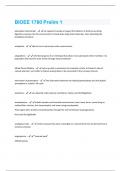
-
BIOEE 1780 Prelim 1 Questions & Answers Rated 100% Correct
- Exam (elaborations) • 18 pages • 2024
-
- $7.99
- + learn more
absorptive heterotroph - An organism (usually a fungus) that obtains its food by secreting digestive enzymes into the environment to break down large food molecules, then absorbing the breakdown products. acidophile - able to live in extremely acidic environments adaptations - inherited aspects of an individual that allow it to outcompete other members of a population that lack the trait; evolve through natural selection Alfred Russel Wallace - came up with a mechanism for evolution simila...
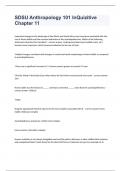
-
SDSU Anthropology 101 InQuizitive Chapter 11 2023/2024
- Exam (elaborations) • 7 pages • 2024
-
Available in package deal
-
- $12.99
- + learn more
SDSU Anthropology 101 InQuizitive Chapter 11Important changes in the landscape of East Africa and South Africa may have been associated with the rise of Homo habilis and the eventual extinction of the australopithecines. Which of the following statements describe this transition? - correct answer -Underground plant parts (edible roots, etc.) became more important, which increased selection for the use of tools. -Habitat changes correlated with changes in cranial and tooth morphology in Homo h...
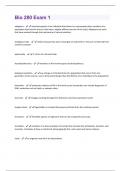
-
Bio 280 Exam 1 Questions And Answers With Verified Tests
- Exam (elaborations) • 5 pages • 2024
- Available in package deal
-
- $7.99
- + learn more
adaptions - inherited aspects of an individual that allow it to outcompete other members of a population that lack the trait (or that have a slightly different version of the trait). Adaptions are traits that have evolved through the mechanism of natural selection analogous traits - similar because they have converged on shared form. they are not derived from common ancestor apamorphy - • a form of a derived state Australopithecines - members of the hominin genus Australopithecus biolog...

Study stress? For sellers on Stuvia, these are actually golden times. KA-CHING! Earn from your study resources too and start uploading now. Discover all about earning on Stuvia


